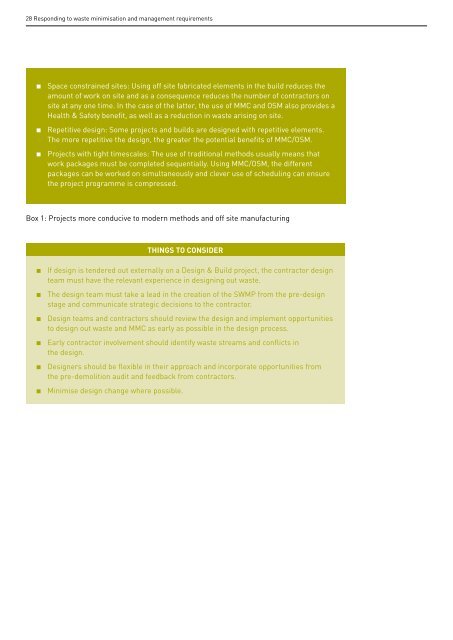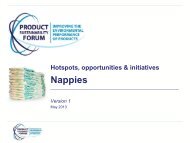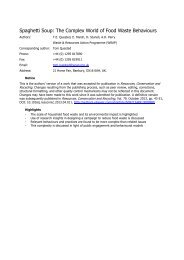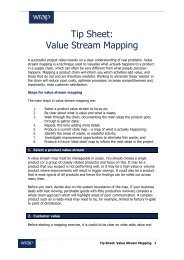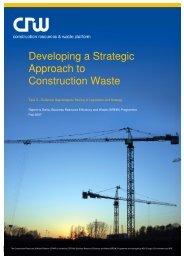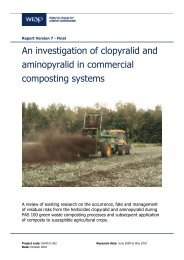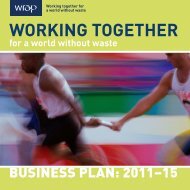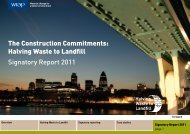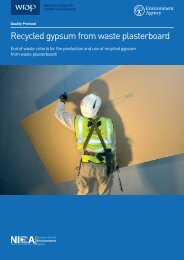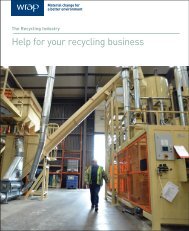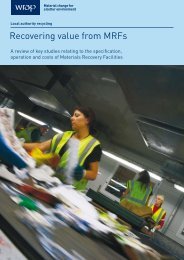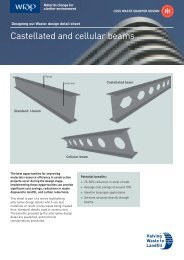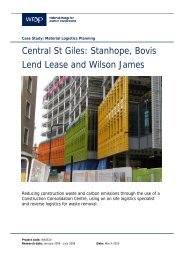Responding to waste minimisation and management ... - Wrap
Responding to waste minimisation and management ... - Wrap
Responding to waste minimisation and management ... - Wrap
You also want an ePaper? Increase the reach of your titles
YUMPU automatically turns print PDFs into web optimized ePapers that Google loves.
28 <strong>Responding</strong> <strong>to</strong> <strong>waste</strong> <strong>minimisation</strong> <strong>and</strong> <strong>management</strong> requirements <strong>Responding</strong> <strong>to</strong> <strong>waste</strong> <strong>minimisation</strong> <strong>and</strong> <strong>management</strong> requirements 29<br />
Space constrained sites: Using off site fabricated elements in the build reduces the<br />
amount of work on site <strong>and</strong> as a consequence reduces the number of contrac<strong>to</strong>rs on<br />
site at any one time. In the case of the latter, the use of MMC <strong>and</strong> OSM also provides a<br />
Health & Safety benefit, as well as a reduction in <strong>waste</strong> arising on site.<br />
Repetitive design: Some projects <strong>and</strong> builds are designed with repetitive elements.<br />
The more repetitive the design, the greater the potential benefits of MMC/OSM.<br />
4 Procurement<br />
Projects with tight timescales: The use of traditional methods usually means that<br />
work packages must be completed sequentially. Using MMC/OSM, the different<br />
packages can be worked on simultaneously <strong>and</strong> clever use of scheduling can ensure<br />
the project programme is compressed.<br />
Box 1: Projects more conducive <strong>to</strong> modern methods <strong>and</strong> off site manufacturing<br />
THINGS TO CONSIDER<br />
If design is tendered out externally on a Design & Build project, the contrac<strong>to</strong>r design<br />
team must have the relevant experience in designing out <strong>waste</strong>.<br />
The design team must take a lead in the creation of the SWMP from the pre-design<br />
stage <strong>and</strong> communicate strategic decisions <strong>to</strong> the contrac<strong>to</strong>r.<br />
Design teams <strong>and</strong> contrac<strong>to</strong>rs should review the design <strong>and</strong> implement opportunities<br />
<strong>to</strong> design out <strong>waste</strong> <strong>and</strong> MMC as early as possible in the design process.<br />
Early contrac<strong>to</strong>r involvement should identify <strong>waste</strong> streams <strong>and</strong> conflicts in<br />
the design.<br />
Designers should be flexible in their approach <strong>and</strong> incorporate opportunities from<br />
the pre-demolition audit <strong>and</strong> feedback from contrac<strong>to</strong>rs.<br />
Minimise design change where possible.<br />
The procurement of both project teams<br />
<strong>and</strong> the materials ordered has a significant<br />
impact on good practice WMM. Optimising<br />
procurement processes can help <strong>to</strong> ensure<br />
that you are employing people who are<br />
experienced <strong>and</strong> capable in the WMM initiative<br />
<strong>and</strong> also ascertain that frameworks are in<br />
place with the right partners <strong>to</strong> minimise<br />
<strong>waste</strong> down the supply chain before<br />
reaching site.<br />
In addition, the procurement of accurate<br />
<strong>and</strong> reliable material quantities required<br />
on a project can reduce the occurrence of<br />
surplus materials brought <strong>to</strong> site only <strong>to</strong> be<br />
<strong>waste</strong>d. Contingency ordering <strong>to</strong> account<br />
for <strong>waste</strong> is often inaccurate <strong>and</strong> unreliable<br />
<strong>and</strong> results in over ordering <strong>and</strong> material<br />
wastage. An accurate assessment of the<br />
materials required should be made, along<br />
with an informed allowance for wastage.<br />
This is primarily a subcontract issues as it is<br />
subcontrac<strong>to</strong>rs who usually place orders for<br />
materials with suppliers.<br />
4.1 Designer, subcontrac<strong>to</strong>r <strong>and</strong> <strong>waste</strong><br />
<strong>management</strong> procurement<br />
Assessment of capacity <strong>and</strong> competence<br />
<strong>to</strong> respond <strong>to</strong> a requirement for <strong>waste</strong><br />
<strong>management</strong> <strong>and</strong> <strong>minimisation</strong> should be<br />
included in pre-qualification processes for all<br />
parties involved in delivering a project (e.g.<br />
designers, contrac<strong>to</strong>rs, subcontrac<strong>to</strong>rs<br />
<strong>and</strong> consultants).<br />
This information could be requested through<br />
the use of a pre-qualification questionnaire<br />
followed by an in-depth interview <strong>to</strong> explore<br />
these issues. The use of a pre-qualification<br />
questionnaire allows the supplier <strong>to</strong><br />
prepare for the interview <strong>and</strong> highlights the<br />
importance of the <strong>waste</strong> issue. For further<br />
information on example pre-qualification<br />
<strong>and</strong> interview questions including guidance<br />
on how <strong>to</strong> structure <strong>and</strong> word forms of<br />
appointment for suppliers refer <strong>to</strong> WRAP’s<br />
Achieving Good Practice Waste Minimisation<br />
<strong>and</strong> Management guide, 7 where model<br />
procurement wording is available.<br />
4.1.1 Designers <strong>and</strong> subcontrac<strong>to</strong>rs<br />
What we really want <strong>to</strong> know from designers<br />
<strong>and</strong> subcontrac<strong>to</strong>rs at the tender stage is<br />
whether they have the skills <strong>and</strong> experience<br />
<strong>to</strong> implement good practice <strong>waste</strong><br />
<strong>minimisation</strong> <strong>and</strong> <strong>management</strong>. It is critically<br />
important <strong>to</strong> achieving a minimal <strong>waste</strong><br />
approach that designers <strong>and</strong> subcontrac<strong>to</strong>rs<br />
are able <strong>to</strong> implement good practice <strong>waste</strong><br />
<strong>management</strong> <strong>and</strong> <strong>minimisation</strong> <strong>and</strong> can<br />
identify <strong>waste</strong> recovery quick wins both in<br />
the design process <strong>and</strong> on site. Therefore,<br />
they should be able <strong>to</strong> demonstrate an<br />
appropriate awareness <strong>and</strong> working<br />
knowledge accordingly.<br />
In particular, the subcontrac<strong>to</strong>r has a<br />
key role in developing <strong>waste</strong> estimates <strong>to</strong><br />
inform SWMP development. Thus, linking<br />
procurement of subcontract packages <strong>to</strong> the<br />
Site Waste Management Plan ensures that<br />
specialist trade input is obtained <strong>and</strong> accurate<br />
figures are used in the <strong>waste</strong> estimates for<br />
the project. Main contrac<strong>to</strong>rs, must therefore<br />
ensure that, where possible, subcontrac<strong>to</strong>rs<br />
are engaged <strong>and</strong> challenged on the <strong>waste</strong><br />
they are likely <strong>to</strong> generate (see overleaf<br />
section 4.2 on Materials Procurement<br />
<strong>and</strong> <strong>waste</strong> forecasts).<br />
If an interview stage is included, questions<br />
could check the specific skills <strong>and</strong> knowledge<br />
levels required by each type of consultant.<br />
Whilst it is important that all consultants<br />
<strong>and</strong> contrac<strong>to</strong>rs underst<strong>and</strong> the issue of<br />
good practice Waste Management <strong>and</strong><br />
7. http://www.wrap.org.uk/construction


